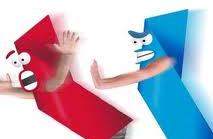As I move toward my certification as an EFT (Emotional Freedom Technique or “tapping”) Abundance Coach from Carol Look, I’ve been holding sessions with many different kinds of clients on their various problems. These could be financial or physical or emotional. As I listen closely and we work to lessen their worry or frustration so we can look for solutions, in the back of my mind I am also thinking about vision and vision improvement. How is what I am learning with this client applicable to my life too, and to my vision students?
Even though I am still pretty new as an EFT practitioner, I am already seeing repeated themes and patterns. Whatever the apparent problem, it’s common that people will feel so overwhelmed there will be no obvious place to start. So they do nothing, and the problem continues or gets worse. Or perhaps they work fiercely to overcome some issue, striving and struggling, sacrificing money and time, exhausting themselves, yet making minimal progress.
With these 2 extremes spelled out, it’s clearer that the way to a solution is the oft-cited Middle Way. Focus on what you can do, make a plan, and start executing it. Don’t push and strain (thank you, Dr. Bates!). And don’t just sit there passively watching the world go by while you do nothing at all, either. Looking at myself and my history, I regret to say I haven’t taken this wise approach for most of my life. The harder the problem, the more I pushed myself. Not to do this was to be lazy!
Today I do have a more balanced approach in my life, most of the time. I’m also starting to implement this with my vision improvement. I accept what I can see, whatever the weather, and don’t get upset when there’s blur. I look for the details I can see, easily and curiously, and often the details within the blur get clearer. If I don’t manage to fit in an eye chart session on a very busy day, I don’t beat myself up. I just do some extra Long Swings before I go to bed, and make sure I do the chart work the next day.
Remembering my stressed childhood when it seemed that whatever I did wasn’t good enough or fast enough, I can now see some of the roots of my habitual straining attitude and straining behavior. Good enough was never good enough — things had to be perfect. A key piece here is my emotions, which there was no room for when I was a child. If I was frightened about not pleasing my mother because I was too slow in getting my chores done, the solution wasn’t to comfort me. It was to push me harder.
The correlation with eyeglasses is obvious to me. When I wore strong hard contact lenses all those years, I felt like I was pushing my eyes to see clearly. It was like riding a horse while carrying a whip, beating him to run as fast as he could. At the end of the day when I took off my contacts to go to bed, I could feel my whole body sigh with relief. I was off-stage now, finally, and didn’t have to perform any longer.
As I started to improve my vision, when I took off my eyeglasses sometimes, and reduced the strength of the ones I wore, I could feel this striving pattern softening a bit. A few times I caught myself alarmed at the thought that I was “goofing off” by not trying and striving as hard as I could. I felt like a laborer taking a break, hoping the strict boss wouldn’t catch him. The cognitive shift that had to happen for me was to know and believe fully that my time is my own, and how to spend it is my own choice. And I can be as “productive”, or not, as I choose to. This was definitely not the case when I was a child.
So I’m wondering now if those strong glasses at age 5 not only froze my visual state, they locked in my anxious emotional state too. And as the glasses got stronger, both my vision and my emotions got even less mobile and more stuck. Rather than mourn my contracted restricted childhood, I’m happy to be undoing it. I am certainly more playful now, several decades later, than I was allowed to be as a child. Both my emotions, and my vision, are freer and healthier than they’ve ever been, and I expect that to continue. It’s never too late to have a joyous bright-eyed clear-seeing childhood!
get help on our Facebook Group!

I wore strong glasses, then contact lenses, from age 5 into my 40s. While making many mistakes, eventually l learned how to improve the way I use my eyes and to see in a more relaxed, healthy manner. It is my pleasure to coach others to do the same. Visit me at https://NancyLNeff.com.
